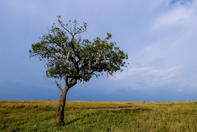
Name
Sausage Tree (Kigelia pinnata) The sausage tree carries beautiful flowers varying from blood red to maroon, hanging down in long panicles. Animals such as bushpigs, the impala, duikers, baboons and lovebird come to feed from the low hanging flowers, rich in nectar.
Its scent is unpleasing to humans but attracts its pollinator – the dwarf epauletted fruit bat (Micropteropus pusillus). From these beautiful flowers grey fruits grow for months into a sausage-like shape. becoming over 30 cm long and weighing over 4.5 kg.
Flowers and Fruit
The South African sausage tree’s flowers bloom at night, hanging on long, ropelike stalks from its limbs. Its nectar-rich blossoms are pollinated by sunbirds, insects and bats. The mature fruit sway from the stalks, like giant sausages.Uses
The pods are treasured as religious charms and talismans, and when boiled create a red dye. The rind of the fruit is added to local brews to aid the fermentation process. The fruit is used to make an ointment that treats skin conditions. The ‘sausage’ part of the tree is not edible, although its skin is used as external medicine when pulped, particularly treating skin conditions such as skin cancer.
These ointments are made by burning the ‘sausage’s’ skin, grinding it with water and oil to make a paste which is then applied. Mekoro, which are canoes that have been used as transportation on the Okavango River Delta for thousands of years, are made from the roots and trunks of sausage trees.